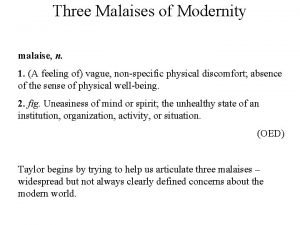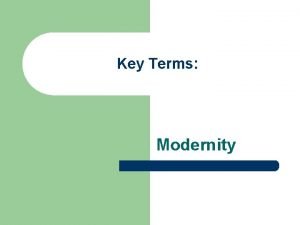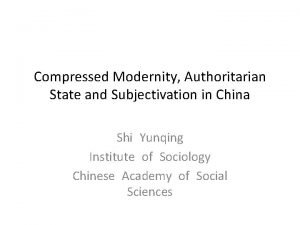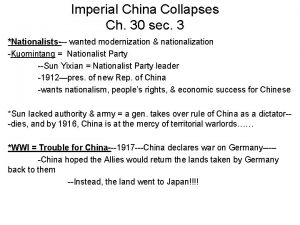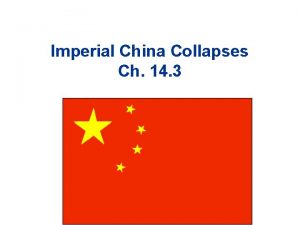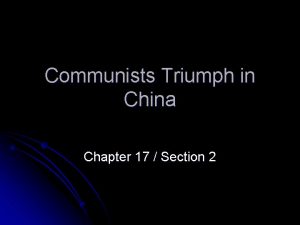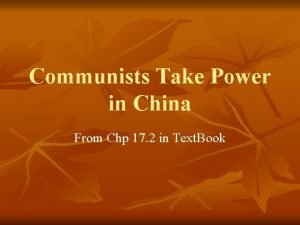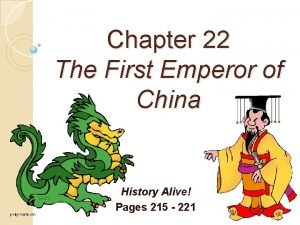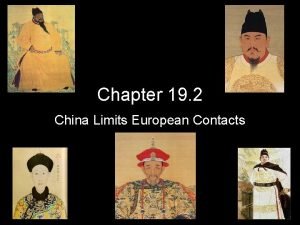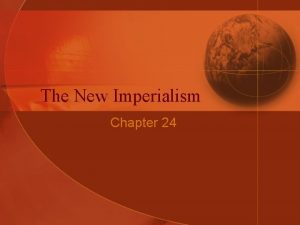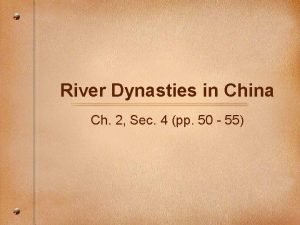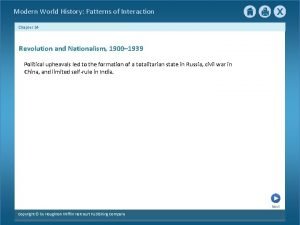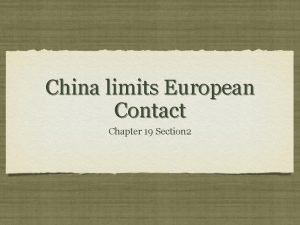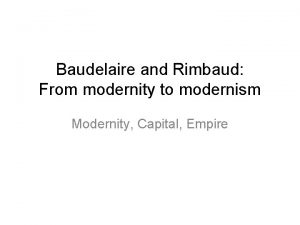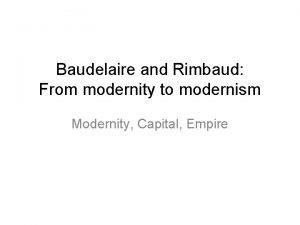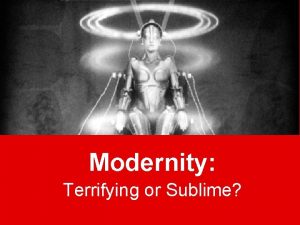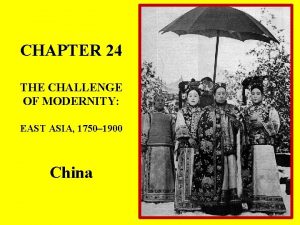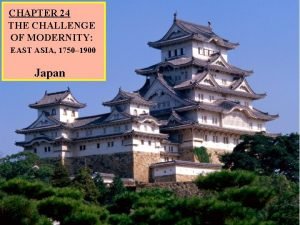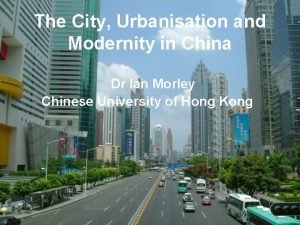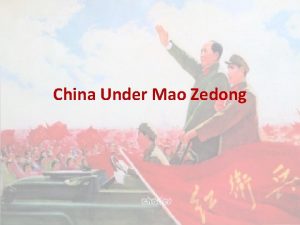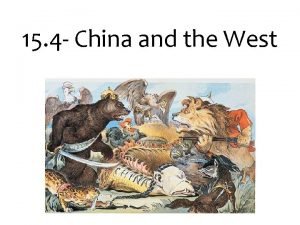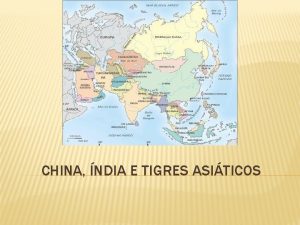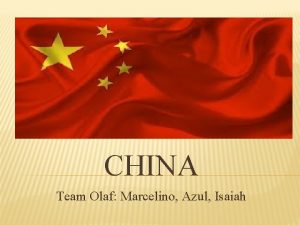Chapter 24 The Challenge of Modernity in China

























































- Slides: 57

Chapter 24 The Challenge of Modernity in China, Japan, and India, 1800– 1910 Copyright © 2017 Cengage Learning. All Rights Reserved.

Learning Objectives (Slide 1 of 4) ▪ ▪ ▪ Outline how Fukuzawa Yûkichi’s ideas about learning, government, and society greatly influenced the Meiji Restoration Summarize the main forces that undermined the power of the Qing dynasty in the nineteenth century Discuss how the Taiping rebellion made Qing China more dependent on European powers Copyright © 2017 Cengage Learning. All Rights Reserved.

Learning Objectives (Slide 2 of 4) ▪ ▪ ▪ Explain the importance of the Self. Strengthening Movement and Boxer Rebellion Identify the factors that made it possible for Japan to be transformed from a relatively isolated society to a major world power Analyze the Meiji reforms and how they transformed Japan, socially, economically, and politically Copyright © 2017 Cengage Learning. All Rights Reserved.

Learning Objectives (Slide 3 of 4) ▪ ▪ ▪ Describe the motivations behind Japanese imperial expansion Explain the impact the British East India Company, industrialization, and colonization had on the economy and culture of India Discuss how British-ruled Indians responded to imperialism Copyright © 2017 Cengage Learning. All Rights Reserved.

Learning Objectives (Slide 4 of 4) ▪ ▪ Discuss the rise of Indian nationalism and the forms it took Analyze how and why Chinese, Japanese, and Indian societies responded differently to the challenges of industrial modernity Copyright © 2017 Cengage Learning. All Rights Reserved.

Introduction ▪ In 1859, Japan sent its first delegation to the United States ▪ Among those sent was Fukuzawa Yûkichi , a twenty-four-year-old samurai ▪ ▪ Fukuzawa represented a westernizing faction of the Japanese government During the nineteenth century, East Asia faced many tremendous changes ▪ They had to decide if they would resist or emulate the West Copyright © 2017 Cengage Learning. All Rights Reserved.

Fukuzawa Yûkichi grew up in a lowranking samurai family that was expected to give unconditional support and service to their lord, but he was an ambitious nonconformist. Becoming convinced of the merits of Western science, he developed a philosophy that emphasized independence over subservience and science over tradition. As a young man he dedicated himself to “Dutch learning”. Copyright © 2017 Cengage Learning. All Rights Reserved.

The Travels of Fukuzawa Yûkichi Copyright © 2017 Cengage Learning. All Rights Reserved.

MTSAU Ep 9 Revolutions 27: 01 -31: 30

China’s World Inverted, 1800– 1906 ▪ After 1800, the increase in wealth in Europe from industrialization also increased the interest in more trade with China ▪ ▪ Industrialists wanted to open up Chinese markets to their products The Qing dynasty, however, sought to keep China isolated from Western trade Copyright © 2017 Cengage Learning. All Rights Reserved.

Qing China Confronts the Industrial World, 1800– 1850 (Slide 1 of 3) ▪ British East India Company, in the late eighteenth century, had few trade goods except for silver ▪ ▪ After Britain dominated opium-producing regions in India, they began to exchange illicit opium with China Qing government was very concerned about the increase in the opium trade, which openly flouted the authority of the Qing officials Copyright © 2017 Cengage Learning. All Rights Reserved.

Qing China Confronts the Industrial World, 1800– 1850 (Slide 2 of 3) ▪ In 1839, the Qing declared that drug traders would be beheaded and opium trade suppressed ▪ Opium War (1839– 1842) humiliated China ▪ ▪ British used iron gunboats – blockaded the Chinese coast ; bombarded coastal cities Qing officials agreed to negotiate a truce The War On Opium - Addicted To Pleasure BBC The Opium War - Lost in Compensation l HISTORY OF CHINA Copyright © 2017 Cengage Learning. All Rights Reserved.

Qing China Confronts the Industrial World, 1800– 1850 (Slide 3 of 3) ▪ Treaty of Nanjing (1842) was the first of a series of unequal treaties that favored the British ▪ ▪ ▪ Opened up five treaty ports; unrestricted to foreign trade British citizens were granted extraterritoriality Europe was not satisfied with the treaty ports and wanted more ▪ Qing agreed to another treaty, which opened up even more treaty ports Copyright © 2017 Cengage Learning. All Rights Reserved.

The Taiping Rebellion, 1850– 1864 (Slide 1 of 3) ▪ Some Chinese questioned whether the Qing had lost the “Mandate of Heaven” ▪ ▪ ▪ Qing China faced internal pressures from poverty, overpopulation, and bureaucratic misrule Between 1800 and 1850, the Chinese population grew by over 100 million Overuse and poor soil led to smaller agricultural yields and to widespread hunger ▪ Yet taxes increased to pay for the military Copyright © 2017 Cengage Learning. All Rights Reserved.

The Taiping Rebellion, 1850– 1864 (Slide 2 of 3) ▪ In 1850, Hong Xiuquan began the Taiping Rebellion in the Guangdong Province ▪ ▪ Hong promised his followers equality, food, and clothing; attracted thousands of followers Many of those who followed Hong were Hakka people ▪ Hakka were only brought under imperial control during Ming times Copyright © 2017 Cengage Learning. All Rights Reserved. Taiping Rebellion | 3 Minute History

The Taiping Rebellion, 1850– 1864 (Slide 3 of 3) ▪ In late 1850, twenty thousand Taiping rebels defeated an imperial army ▪ ▪ ▪ Marched on Nanjing in 1853 Taiping Rebellion collapsed after 1853 In the 1860 s, British and French troops fought the Taiping on behalf of the Qing ▪ Left the Qing even more dependent on foreign aid Copyright © 2017 Cengage Learning. All Rights Reserved.

“Self-Strengthening” and the Boxer Rebellion, 1842– 1901 (Slide 1 of 7) ▪ After the Opium War, many educated Chinese argued that the Qing government had to reform ▪ ▪ More Western capitalists arrived; looked for new markets or cheap labor Self-Strengthening Movement created to reform China ▪ Intention was to modernize China industrially without sacrificing traditional Chinese culture Copyright © 2017 Cengage Learning. All Rights Reserved.

“Self-Strengthening” and the Boxer Rebellion, 1842– 1901 (Slide 2 of 7) ▪ First area to be reformed was education ▪ ▪ ▪ Western scientific texts were translated at government institutions Some Manchu and Chinese men went to Europe and the United States; studied Western technology Neo-Confucian conservatives objected to the Self-Strengthening Movement ▪ Saw it as violating Confucian traditions Copyright © 2017 Cengage Learning. All Rights Reserved.

“Self-Strengthening” and the Boxer Rebellion, 1842– 1901 (Slide 3 of 7) ▪ Empress Ci Xi ruled China as regent ▪ ▪ ▪ Ci Xi supported the conservative, anti. Western forces in China Ci Xi had been the concubine of an emperor; ruled as regent during the reign of two child emperors, her nephews Ci Xi wanted only to preserve imperial power Copyright © 2017 Cengage Learning. All Rights Reserved. Cixi: All Power to the Empress Dowager l HISTORY OF CHINA

“Self-Strengthening” and the Boxer Rebellion, 1842– 1901 (Slide 4 of 7) ▪ In spite of Ci Xi’s efforts, China was overwhelmed by Western powers and by Japan ▪ ▪ In 1884, the Qing lost control of Vietnam and Southeast Asia to the French In 1894– 1895, the Qing lost the Sino. Japanese War and control of Korea to Japan Copyright © 2017 Cengage Learning. All Rights Reserved.

“Self-Strengthening” and the Boxer Rebellion, 1842– 1901 (Slide 5 of 7) ▪ After these military defeats, Chinese reformers won official support in 1898 ▪ Young Guangxu emperor issued a series of reform edicts ▪ ▪ ▪ First move was again to reform education Ci Xi retaliated; Guangxu confined to the palace Meanwhile, the aggression of external powers intensified Copyright © 2017 Cengage Learning. All Rights Reserved.

“Self-Strengthening” and the Boxer Rebellion, 1842– 1901 (Slide 6 of 7) ▪ Many Chinese in the late nineteenth century joined secret societies ▪ “Society of Righteous and Harmonious Fists” were also known as the Boxers ▪ ▪ Emphasized martial arts In 1898, the Boxers attacked Christian missionaries; began the Boxer Rebellion ▪ Once again, European powers put down a Chinese rebellion Sound Smart: The Boxer Rebellion | History The Boxer Rebellion l HISTORY OF CHINA Copyright © 2017 Cengage Learning. All Rights Reserved.

“Self-Strengthening” and the Boxer Rebellion, 1842– 1901 (Slide 7 of 7) ▪ Manchu government finally implemented substantial reforms ▪ ▪ Abolished examination system Made plans for a constitutional order with some degree of popular representation Abolished foot binding In 1912, revolutionaries overthrew the decrepit Qing dynasty Copyright © 2017 Cengage Learning. All Rights Reserved.

A Qing Arsenal A major focus of the Self-Strengthening Movement was military modernization. Here Qing officials survey a cannon at an arsenal built in 1865, after the suppression of the Taiping Rebellion. The reformers hoped to achieve self-sufficiency in military infrastructure with the aid of foreign advisers; however, the corruption and inefficiency of the imperial bureaucracy prevented them from achieving that goal. Copyright © 2017 Cengage Learning. All Rights Reserved.

Asia in 1910 Copyright © 2017 Cengage Learning. All Rights Reserved.

The Boxer Rebellion: American View The Boxer Rebellion (1898– 1901) marked the death throes of the Qing dynasty. The decision of the Dowager Empress, Ci Xi, to support the “Righteous Society of Harmonious Fists” against the “Western barbarians” was calamitous. In 1912, a new Republic of China marked the final end of China’s long imperial history. Copyright © 2017 Cengage Learning. All Rights Reserved.

The Boxer Rebellion: French View Another principal grievance of the Boxers was the partition of China into Western “spheres of influence. ” But in the end, their uprising only led to further foreign interference. Though the United States, with its Open Door Policy, proclaimed its opposition to the further partition of China, the division of the world’s oldest and most populous empire continued unabated. Copyright © 2017 Cengage Learning. All Rights Reserved.


The Rise of Modern Japan, 1830– 1905 ▪ Late Tokugawa society, 1830– 1867 ▪ ▪ Tokugawa society in Japan remained very hierarchical in structure Fukuzawa’s lower-status samurai family was caught between two social worlds ▪ ▪ In his village, Fukuzawa was treated dismissively by the children of the higherranking samurai families But, the lowest-ranking samurai still outranked the farmers, artisans, merchants, and outcasts Copyright © 2017 Cengage Learning. All Rights Reserved.

Late Tokugawa Society, 1830– 1867 (Slide 1 of 4) ▪ Education was Fukuzawa’s path to success and out of his class limitations ▪ ▪ His father was well educated in the Confucian classics Fukuzawa had no formal education until age fourteen ▪ Received his family’s permission to travel to Nagasaki to study in Nagasaki, the center of “Dutch learning” Copyright © 2017 Cengage Learning. All Rights Reserved.

Late Tokugawa Society, 1830– 1867 (Slide 2 of 4) ▪ In 1853, Commodore Matthew Perry sailed into Edo harbor ▪ Perry arrived with his steam-powered “black ships” as a show of American technological power In 1858, the shogun signed an unequal treaty with the United States and five European powers Samurai, Daimyo, Matthew Perry, and Nationalism: Crash Course World History #34 ▪ ▪ Opened Japan’s trade to the United States and other Western countries Copyright © 2017 Cengage Learning. All Rights Reserved.

Commodore Perry’s Arrival in Japan This Japanese print shows the arrival of Commodore Matthew Perry’s steampowered “black ships” near Edo (modern Tokyo) in 1853. After Perry’s return to Japan in 1854, demanding that Japan be opened to Western trade, Japanese leaders debated how best to respond. Copyright © 2017 Cengage Learning. All Rights Reserved.

Late Tokugawa Society, 1830– 1867 (Slide 3 of 4) ▪ Some daimyo lords objected to this treaty and accused the shogun of humiliating Japan ▪ ▪ ▪ Wanted to use this crisis to regain some of the privileges the Tokugawa had taken away Acquired Western weapons and fired at European ships The shogun sent a delegation to Europe in 1862 to prevent future unequal treaties Copyright © 2017 Cengage Learning. All Rights Reserved.

Late Tokugawa Society, 1830– 1867 (Slide 4 of 4) ▪ By 1863, there were two factions against the shogun ▪ ▪ The daimyo, who blamed the shogun for the treaties with the West The rônin, or masterless samurai, who were antiforeign Copyright © 2017 Cengage Learning. All Rights Reserved.

The Meiji Restoration, 1867– 1890 (Slide 1 of 7) ▪ ▪ In order to present a strong response to the challenge of Western powers, Japan needed to unify behind one cause In 1868, the Meiji Restoration established a new imperial government ▪ The capital was established at Edo, which was renamed Tokyo Japanese History of Edo period to Meiji Restoration(1/6) Copyright © 2017 Cengage Learning. All Rights Reserved.

The Meiji Restoration, 1867– 1890 (Slide 2 of 7) ▪ Meiji reforms ended the daimyo-ruled domains; established regional prefectures under a centralized government ▪ ▪ ▪ Tax collections were centralized National, conscript army created; commoners allowed to carry guns All class distinctions between the samurai and other classes abolished Copyright © 2017 Cengage Learning. All Rights Reserved.

The Meiji Restoration, 1867– 1890 (Slide 3 of 7) ▪ ▪ ▪ Fukuzawa’s role for the new government: Encourage education and reform Meiji oligarchs’ policy: Adapt Western methods to strengthen Japan; resist intrusion; engage the world as an equal Some Japanese were critical of this new direction ▪ 1877: Saigō Takamori led 42, 000 samurai in the Satsuma Rebellion Copyright © 2017 Cengage Learning. All Rights Reserved. The Last Samurai Official Trailer #1 - (2003) HD

The Meiji Restoration, 1867– 1890 (Slide 4 of 7) ▪ With industrialization came an unequal distribution of the new economic rewards ▪ To make ends meet, many rural families sent their daughters to work in factories ▪ Fukuzawa was critical of poor pay and strict supervision Copyright © 2017 Cengage Learning. All Rights Reserved.

The Meiji Restoration, 1867– 1890 (Slide 5 of 7) ▪ Kishida Toshiko advocated women should have equal access to modern education and be allowed to take part in public affairs ▪ Gender debate exemplifies another of Fukuzawa’s contributions – his encouragement of open discussions Copyright © 2017 Cengage Learning. All Rights Reserved.

The Meiji Restoration, 1867– 1890 (Slide 6 of 7) ▪ 1873: Fukuzawa returned from a new mission to Europe; impressed with newly unified Germany ▪ Japanese constitution of 1889 based on the German one Copyright © 2017 Cengage Learning. All Rights Reserved.

The Meiji Restoration, 1867– 1890 (Slide 7 of 7) ▪ Meiji reforms granted the government a direct role in industrial development ▪ ▪ State constructed railroads, rebuilt harbors, strung telegraph lines, and directly invested money in new industries In the 1880 s, the government sold most industrial assets to private investors ▪ After 1880, Japanese industry was dominated by zaibatsu, large industrial cartels that collaborated closely with the civil service Copyright © 2017 Cengage Learning. All Rights Reserved.

MTSAU Ep 11, Speed 6: 34 -13: 59 Japan and Modernization

Japanese Imperialism, 1890– 1910 (Slide 1 of 2) ▪ First region of Japanese imperial aggression was Korea ▪ ▪ ▪ Japanese victory in the consequent Sino. Japanese War (1894– 1895) caused a wave of national pride Meiji government forced Qing China to grant access to treaty ports and rights of extraterritoriality Japan renegotiated its own treaties with Europe, this time on a basis of equality First Sino-Japanese War | 3 Minute History Copyright © 2017 Cengage Learning. All Rights Reserved.

Japanese Imperialism, 1890– 1910 (Slide 2 of 2) ▪ Japan pressured Korea to adopt reforms ▪ ▪ ▪ Korean king allied himself with the Japanese; then in 1896, he sought protection from the Russians Russo-Japanese War (1904– 1905) followed; won by Japan 1910: Meiji government annexed Korea Russo-Japanese War | 3 Minute History Copyright © 2017 Cengage Learning. All Rights Reserved.

Peace Negotiations This print by Kiyochika Kobayashi shows Japanese and Chinese negotiations at the end of the Sino-Japanese War. By the terms of the Treaty of Shimonoseki (1895), the Qing empire ceded the island of Taiwan to Japan, recognized Japanese rights over Korea, and agreed to make substantial reparation payments. Copyright © 2017 Cengage Learning. All Rights Reserved.

Asian Responses to Imperialism: Crash Course World History #213

British India, 1818– 1905 ▪ The last phase of East India company rule in India, 1835– 1857 ▪ Implications of British rule for Indians greatly intensified ▪ ▪ At the same time, India was deindustrialized ▪ ▪ Reasons were largely economic – part of the impact of the industrial revolution Led to increased unemployment Cultural distancing contributed to a tense political situation in the 1850 s The British Empire and India Copyright © 2017 Cengage Learning. All Rights Reserved.

The Indian Revolt of 1857 and Its Aftermath (Slide 1 of 2) ▪ Indian Revolt of 1857 began among the sepoys ▪ ▪ ▪ Revolt spread across northern and western India Revolt was often cruel on both sides After the revolt, racial stereotyping by the British became pronounced ▪ Social Darwinism also led to more tension between English and Indians Sepoy Mutiny - Revolt of 1857 | Mangal Pandey | History of India | Educational Videos by Mocomi Kids Copyright © 2017 Cengage Learning. All Rights Reserved. Sepoy Rebellion 9 min

The Indian Revolt of 1857 and Its Aftermath (Slide 2 of 2) ▪ With the end of the revolt in 1858, British Crown seized direct control of India ▪ ▪ ▪ British East India Company was disbanded In 1876, Queen Victoria called herself “Empress of India” In 1885, Indian National Congress created to promote Indian nationalism Copyright © 2017 Cengage Learning. All Rights Reserved.

Princely States Since the nineteenth century, Hindu spirituality, including the practice of yoga, has had a global appeal. Swami Vivekananda (1863– 1902) played an important role, developing a large following in Europe, and in the United States after he addressed an international religious gathering in Chicago at the time of the Columbian Exposition. Like members of the earlier Bengal Renaissance, Vivekananda advocated a reformed Hinduism purged of superstition and caste prejudice. Copyright © 2017 Cengage Learning. All Rights Reserved.

Indian Railroads, 1893 The first British railway Copyright © 2017 Cengage Learning. All Rights Reserved.

The Origins of Indian Nationalism, 1885 – 1906 (Slide 1 of 3) ▪ English encouraged the building of railroads across India ▪ ▪ ▪ This provided a market for British manufacturers Indian taxpayers paid for the new railroads Indian nationalism was encouraged by a growing middle class ▪ Middle class was educated in English language schools, following British curricula Copyright © 2017 Cengage Learning. All Rights Reserved.

The Origins of Indian Nationalism, 1885 – 1906 (Slide 2 of 3) ▪ First leaders of the Indian National Congress were wealthy men who promoted interests of their own social class ▪ ▪ Initially, they believed that slow reform was better than revolutionary change Less patient Indian nationalists, notably Bal Gangadhar Tilak, took a more confrontational approach Copyright © 2017 Cengage Learning. All Rights Reserved.

The Origins of Indian Nationalism, 1885 – 1906 (Slide 3 of 3) ▪ British promised “good government” and improvement to India ▪ ▪ ▪ 1896– 1897: Monsoon rains failed; British failed to move food to famine areas 1903: “Dunbar” procession displayed British governments power; distracted the Indians with pomp and circumstance 1905: No Indians were consulted about the Partition of Bengal Copyright © 2017 Cengage Learning. All Rights Reserved.

The Great Coronation of Delhi Durbar 1911

Swami Vivekananda Since the nineteenth century, Hindu spirituality, including the practice of yoga, has had a global appeal. Swami Vivekananda (1863– 1902) played an important role, developing a large following in Europe, and in the United States after he addressed an international religious gathering in Chicago at the time of the Columbian Exposition. Like members of the earlier Bengal Renaissance, Vivekananda advocated a reformed Hinduism purged of superstition and caste prejudice. Copyright © 2017 Cengage Learning. All Rights Reserved.

Chapter Timeline EVENT East Asia: Lifetime of Fukuzawa Yukichi East Asia: First Opium War East Asia: Treaty of Nanjing East Asia: Taiping Rebellion For Comparison: Second French Empire East Asia: Opening of Japan by Perry South Asia: Indian Revolt For Comparison: Italian Unification South Asia: Lifetime of Gopal. K. Gokhale East Asia: Meiji Restoration For Comparison: Suez Canal Opens For Comparison: German Unification For Comparison: Berlin Conference South Asia: Indian National Congress established East Asia: Boxer Rebellion South Asia: Partition of Bengal East Asia: Japanese Colonization of Korea and Taiwan Copyright © 2017 Cengage Learning. All Rights Reserved. APPROXIMATE DATE(S) (CE) 1835 to 1901 1839 to 1842 1850 to 1864 1852 to 1870 1853 1857 1861 1866 to 1915 1867 to 1868 1869 1871 1884 1885 1898 1905 1910
 Three malaises
Three malaises Modernity ترمس
Modernity ترمس Compressed modernity definition
Compressed modernity definition Teen challenge nottingham
Teen challenge nottingham Hát kết hợp bộ gõ cơ thể
Hát kết hợp bộ gõ cơ thể Slidetodoc
Slidetodoc Bổ thể
Bổ thể Tỉ lệ cơ thể trẻ em
Tỉ lệ cơ thể trẻ em Chó sói
Chó sói Chụp tư thế worms-breton
Chụp tư thế worms-breton Bài hát chúa yêu trần thế alleluia
Bài hát chúa yêu trần thế alleluia Môn thể thao bắt đầu bằng từ chạy
Môn thể thao bắt đầu bằng từ chạy Thế nào là hệ số cao nhất
Thế nào là hệ số cao nhất Các châu lục và đại dương trên thế giới
Các châu lục và đại dương trên thế giới Công thức tính độ biến thiên đông lượng
Công thức tính độ biến thiên đông lượng Trời xanh đây là của chúng ta thể thơ
Trời xanh đây là của chúng ta thể thơ Mật thư tọa độ 5x5
Mật thư tọa độ 5x5 Làm thế nào để 102-1=99
Làm thế nào để 102-1=99 độ dài liên kết
độ dài liên kết Các châu lục và đại dương trên thế giới
Các châu lục và đại dương trên thế giới Thơ thất ngôn tứ tuyệt đường luật
Thơ thất ngôn tứ tuyệt đường luật Quá trình desamine hóa có thể tạo ra
Quá trình desamine hóa có thể tạo ra Một số thể thơ truyền thống
Một số thể thơ truyền thống Cái miệng xinh xinh thế chỉ nói điều hay thôi
Cái miệng xinh xinh thế chỉ nói điều hay thôi Vẽ hình chiếu vuông góc của vật thể sau
Vẽ hình chiếu vuông góc của vật thể sau Thế nào là sự mỏi cơ
Thế nào là sự mỏi cơ đặc điểm cơ thể của người tối cổ
đặc điểm cơ thể của người tối cổ V. c c
V. c c Vẽ hình chiếu đứng bằng cạnh của vật thể
Vẽ hình chiếu đứng bằng cạnh của vật thể Vẽ hình chiếu vuông góc của vật thể sau
Vẽ hình chiếu vuông góc của vật thể sau Thẻ vin
Thẻ vin đại từ thay thế
đại từ thay thế điện thế nghỉ
điện thế nghỉ Tư thế ngồi viết
Tư thế ngồi viết Diễn thế sinh thái là
Diễn thế sinh thái là Các loại đột biến cấu trúc nhiễm sắc thể
Các loại đột biến cấu trúc nhiễm sắc thể Các số nguyên tố là gì
Các số nguyên tố là gì Tư thế ngồi viết
Tư thế ngồi viết Lời thề hippocrates
Lời thề hippocrates Thiếu nhi thế giới liên hoan
Thiếu nhi thế giới liên hoan ưu thế lai là gì
ưu thế lai là gì Hươu thường đẻ mỗi lứa mấy con
Hươu thường đẻ mỗi lứa mấy con Khi nào hổ con có thể sống độc lập
Khi nào hổ con có thể sống độc lập Sơ đồ cơ thể người
Sơ đồ cơ thể người Từ ngữ thể hiện lòng nhân hậu
Từ ngữ thể hiện lòng nhân hậu Thế nào là mạng điện lắp đặt kiểu nổi
Thế nào là mạng điện lắp đặt kiểu nổi Chapter 13 accounting study guide
Chapter 13 accounting study guide Chapter 2 stress the constant challenge
Chapter 2 stress the constant challenge Chapter 30 section 3 imperial china collapses
Chapter 30 section 3 imperial china collapses Chapter 30 section 3 imperial china collapses
Chapter 30 section 3 imperial china collapses Chapter 17 section 2 communists triumph in china
Chapter 17 section 2 communists triumph in china Chapter 17 section 2 communists take power in china
Chapter 17 section 2 communists take power in china Chapter 22 the first emperor of china
Chapter 22 the first emperor of china China limits european contacts
China limits european contacts Chapter 24 section 5 china and the new imperialism
Chapter 24 section 5 china and the new imperialism Chapter 2 section 4: river dynasties in china answer key
Chapter 2 section 4: river dynasties in china answer key Chapter 14 section 3 imperial china collapses
Chapter 14 section 3 imperial china collapses What restrictions did the manchus place on foreign trade
What restrictions did the manchus place on foreign trade
